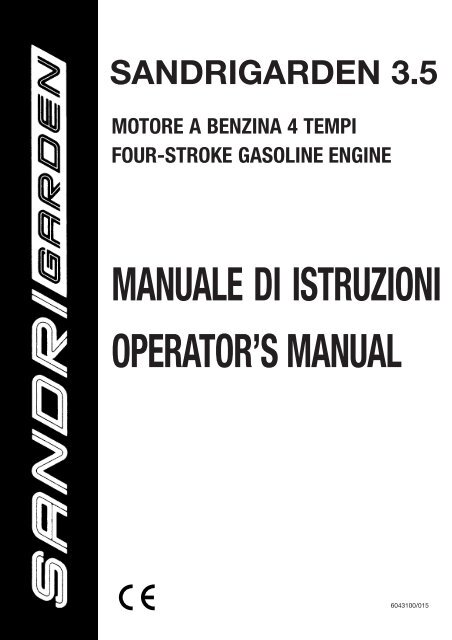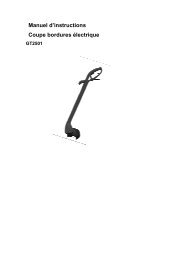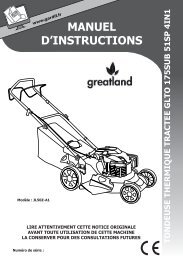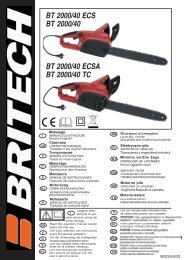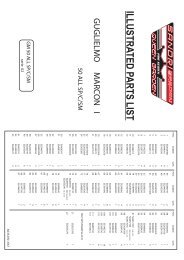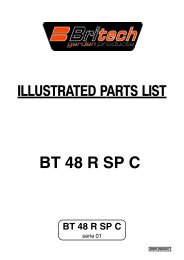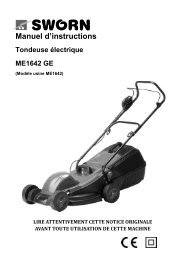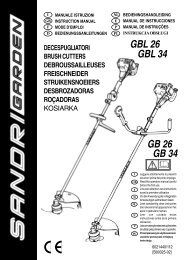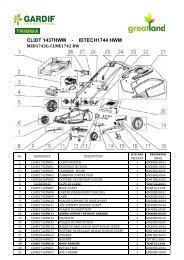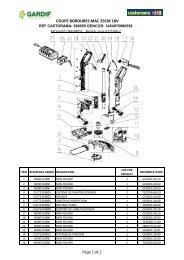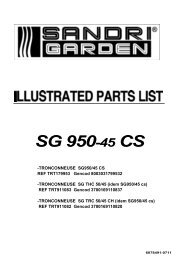motore a benzina 4 tempi manuale di istruzioni operator's manual
motore a benzina 4 tempi manuale di istruzioni operator's manual
motore a benzina 4 tempi manuale di istruzioni operator's manual
You also want an ePaper? Increase the reach of your titles
YUMPU automatically turns print PDFs into web optimized ePapers that Google loves.
SANDRIGARDEN 3.5<br />
MOTORE A BENZINA 4 TEMPI<br />
FOUR-STROKE GASOLINE ENGINE<br />
MANUALE DI ISTRUZIONI<br />
OPERATOR’S MANUAL<br />
6043100/015
3.1<br />
5.1.1<br />
5.1.3<br />
3<br />
5.2-3<br />
3<br />
2 1<br />
4 3<br />
1<br />
1<br />
2<br />
1<br />
11<br />
5<br />
6 7<br />
10 8 9<br />
2<br />
2<br />
MAX<br />
MIN<br />
5.1.2<br />
2<br />
2 1<br />
5.1.4<br />
5.5-6<br />
1 2<br />
2<br />
1<br />
3.2<br />
1 3<br />
1<br />
3<br />
CHOKE<br />
FAST<br />
SLOW
6.3<br />
6.5<br />
6.6<br />
6.7<br />
3<br />
2 1<br />
1<br />
2<br />
6<br />
1<br />
5<br />
1<br />
3<br />
4<br />
4<br />
MAX<br />
MIN<br />
2<br />
1<br />
6.4<br />
2<br />
3<br />
4<br />
1 2<br />
3<br />
1 1<br />
3<br />
0,6-0,8<br />
mm<br />
4
INDICE<br />
1. Informazioni generali ................................. 1<br />
2. Norme <strong>di</strong> sicurezza ................................... 1<br />
3. Componenti e coman<strong>di</strong> ............................ 2<br />
4. Cosa è opportuno sapere ......................... 3<br />
5. Norme d’uso ............................................. 4<br />
6. Manutenzione ........................................... 5<br />
7. Inconvenienti e rime<strong>di</strong> ............................... 7<br />
8. Dati tecnici ................................................ 8<br />
1. INFORMAZIONI GENERALI<br />
1.1<br />
INDICAZIONI PER LA CONSULTAZIONE<br />
Nel testo del <strong><strong>manual</strong>e</strong>, alcuni paragrafi contenenti<br />
informazioni <strong>di</strong> particolare importanza, ai<br />
fini della sicurezza o del funzionamento, sono<br />
evidenziati in mo<strong>di</strong> <strong>di</strong>versi, secondo questo criterio:<br />
NOTA oppure IMPORTANTE<br />
Fornisce precisazioni o altri elementi a quanto<br />
già precedentemente in<strong>di</strong>cato, nell’intento <strong>di</strong><br />
non danneggiare il <strong>motore</strong>, o causare danni.<br />
! ATTENZIONE!<br />
Possibilità <strong>di</strong> lesioni personali<br />
o a terzi in caso <strong>di</strong> inosservanza.<br />
! PERICOLO!<br />
Possibilità <strong>di</strong> gravi lesioni<br />
personali o a terzi con pericolo <strong>di</strong> morte, in<br />
caso <strong>di</strong> inosservanza.<br />
NOTA Tutte le in<strong>di</strong>cazioni “anteriore”,<br />
“posteriore”, “destro” e “sinistro” si intendono<br />
riferite alla posizione <strong>di</strong> lavoro dell’operatore.<br />
2. NORME GENERALI DI SICUREZZA<br />
(Da osservare scrupolosamente)<br />
A) ADDESTRAMENTO<br />
1) Leggere attentamente le <strong>istruzioni</strong> contenute<br />
nel presente <strong><strong>manual</strong>e</strong> e le <strong>istruzioni</strong> del<br />
rasaerba su cui questo <strong>motore</strong> è montato.<br />
Imparare ad arrestare rapidamente il <strong>motore</strong>.<br />
2) Non permettere mai che il <strong>motore</strong> venga<br />
utilizzato da persone che non abbiano la<br />
necessaria <strong>di</strong>mestichezza con le <strong>istruzioni</strong>.<br />
3) Non utilizzare mai il <strong>motore</strong> con persone, in<br />
particolare bambini, o animali nelle vicinanze.<br />
4) Ricordare che l’operatore o l’utilizzatore è<br />
responsabile <strong>di</strong> incidenti e imprevisti che si<br />
IT 1<br />
La corrispondenza fra i riferimenti contenuti nel<br />
testo e le rispettive figure (poste sui due retri<br />
della copertina) è data dal numero che precede il<br />
titolo del paragrafo.<br />
1.2<br />
PITTOGRAMMI DI SICUREZZA<br />
Il vostro <strong>motore</strong> deve essere utilizzato con prudenza.<br />
A tale scopo, sul <strong>motore</strong> sono stati posti<br />
dei pittogrammi, destinati a ricordarvi le precauzioni<br />
d’uso. Il significato è spiegato qui <strong>di</strong> seguito.<br />
Vi raccoman<strong>di</strong>amo inoltre <strong>di</strong> leggere attentamente<br />
le norme <strong>di</strong> sicurezza riportate nell’apposito<br />
capitolo del presente libretto.<br />
Attenzione! - Leggere le <strong>istruzioni</strong><br />
prima dell’uso.<br />
Attenzione! - Tenersi a <strong>di</strong>stanza dalle<br />
superfici calde.<br />
possono verificare ad altre persone o alle loro<br />
proprietà.<br />
B) OPERAZIONI PRELIMINARI<br />
1) Non indossare indumenti larghi, lacci,<br />
gioielli o altri oggetti che potrebbero rimanere<br />
impigliati; raccogliere i capelli lunghi e<br />
rimanere a <strong>di</strong>stanza <strong>di</strong> sicurezza (<strong>di</strong>etro al<br />
manico del rasaerba) durante l’avviamento.<br />
2) Spegnere il <strong>motore</strong> e lasciarlo raffreddare<br />
prima <strong>di</strong> togliere il tappo del serbatoio.<br />
3) ATTENZIONE: PERICOLO! La <strong>benzina</strong> è<br />
altamente infiammabile.<br />
– conservare il carburante in appositi contenitori;<br />
– rabboccare il carburante, utilizzando un<br />
IT
IT<br />
IT 2<br />
imbuto, solo all’aperto e non fumare durante<br />
questa l’operazione e ogni volta che si<br />
maneggia il carburante;<br />
– rabboccare prima <strong>di</strong> avviare il <strong>motore</strong>; non<br />
aggiungere <strong>benzina</strong> o togliere il tappo del<br />
serbatoio quando il <strong>motore</strong> è in funzione o<br />
è caldo;<br />
– se fuoriesce della <strong>benzina</strong>, non avviare il<br />
<strong>motore</strong>, ma allontanare il rasaerba dall’area<br />
nella quale il carburante è stato versato, ed<br />
evitare <strong>di</strong> creare possibilità <strong>di</strong> incen<strong>di</strong>o, fintanto<br />
che il carburante non sia evaporato<br />
ed i vapori <strong>di</strong> <strong>benzina</strong> non si siano <strong>di</strong>ssolti.<br />
– rimettere sempre e serrare bene i tappi del<br />
serbatoio e del contenitore della <strong>benzina</strong>.<br />
4) Sostituire i silenziatori <strong>di</strong>fettosi e la protezione,<br />
se danneggiata.<br />
C) DURANTE L’UTILIZZO<br />
1) Non azionare il <strong>motore</strong> in spazi chiusi, dove<br />
possono accumularsi pericolosi fumi <strong>di</strong><br />
monossido <strong>di</strong> carbonio.<br />
2) Non usare flui<strong>di</strong> <strong>di</strong> avviamento o altri prodotti<br />
analoghi.<br />
3) Non mo<strong>di</strong>ficare le regolazioni del <strong>motore</strong> e<br />
non fare raggiungere al <strong>motore</strong> un regime <strong>di</strong><br />
giri eccessivo.<br />
4) Non inclinare lateralmente il rasaerba al<br />
punto da provocare fuoriuscite <strong>di</strong> <strong>benzina</strong> dal<br />
tappo del serbatoio del <strong>motore</strong>.<br />
5) Non toccare le alette del cilindro e la protezione<br />
del silenziatore fino a quando il <strong>motore</strong><br />
non si sia sufficientemente raffreddato.<br />
6) Fermare il <strong>motore</strong> e staccare il cavo della<br />
candela prima <strong>di</strong> controllare, pulire o lavorare<br />
sul rasaerba o sul <strong>motore</strong>.<br />
7) Non far girare il <strong>motore</strong> senza candela.<br />
8) Trasportare il rasaerba a serbatoio vuoto.<br />
D) MANUTENZIONE E MAGAZZINAGGIO<br />
1) Una manutenzione regolare è essenziale<br />
per la sicurezza e per mantenere il livello<br />
delle prestazioni.<br />
2) Non riporre il rasaerba con della <strong>benzina</strong><br />
nel serbatoio in un locale dove i vapori <strong>di</strong><br />
<strong>benzina</strong> potrebbero raggiungere una fiamma,<br />
una scintilla o una forte fonte <strong>di</strong> calore.<br />
3) Lasciare raffreddare il <strong>motore</strong> prima <strong>di</strong> collocare<br />
il rasaerba in un qualsiasi ambiente.<br />
4) Per ridurre il rischio d’incen<strong>di</strong>o, mantenere<br />
il <strong>motore</strong>, il silenziatore <strong>di</strong> scarico, e la zona <strong>di</strong><br />
magazzinaggio della <strong>benzina</strong> liberi da residui<br />
d’erba, foglie o grasso eccessivo.<br />
5) Se il serbatoio deve essere vuotato, effettuare<br />
questa operazione all’aperto e a <strong>motore</strong><br />
freddo.<br />
6) Non usare mai il <strong>motore</strong> con parti usurate<br />
o danneggiate, per motivi <strong>di</strong> sicurezza. I pezzi<br />
devono essere sostituiti e mai riparati. Usare<br />
ricambi originali. I pezzi <strong>di</strong> qualità non equivalente<br />
possono danneggiare il <strong>motore</strong> e nuocere<br />
alla vostra sicurezza.<br />
3. COMPONENTI E COMANDI<br />
3.1<br />
COMPONENTI DEL MOTORE<br />
1. Manopola della fune <strong>di</strong> avviamento<br />
2. Protezione con serbatoio integrato<br />
3. Tappo serbatoio carburante<br />
4. Tappo riempimento olio con astina <strong>di</strong> livello<br />
5. Coperchio filtro aria<br />
6. Silenziatore <strong>di</strong> scarico<br />
7. Protezione del silenziatore<br />
8. Candela<br />
9. Cappuccio candela<br />
10. Leva regolatore velocità<br />
11. Numero <strong>di</strong> matricola del <strong>motore</strong><br />
3.2<br />
COMANDO ACCELERATORE<br />
✍<br />
Scrivete qui il numero <strong>di</strong> matricola del<br />
vostro <strong>motore</strong><br />
Il comando dell’acceleratore è normalmente<br />
montato sul manico del rasaerba ed è collegato<br />
al <strong>motore</strong> tramite un cavo.<br />
La leva (1) ha tre posizioni corrispondenti a:<br />
CHOKE = da utilizzare per l’avviamento a<br />
freddo.<br />
FAST = corrispondente al regime massimo;<br />
da utilizzare durante il taglio<br />
dell’erba.<br />
SLOW = corrispondente al regime minimo.<br />
EN
4. COSA È OPPORTUNO SAPERE<br />
Il <strong>motore</strong> è un’apparecchiatura le cui prestazioni,<br />
regolarità <strong>di</strong> funzionamento e durata sono con<strong>di</strong>zionati<br />
da molti fattori, alcuni esterni ed altri<br />
strettamente correlati alla qualità dei prodotti<br />
impiegati e alla regolarità della manutenzione.<br />
Qui <strong>di</strong> seguito sono riportate alcune informazioni<br />
aggiuntive che permettono un utilizzo più consapevole<br />
del vostro <strong>motore</strong>.<br />
4.1<br />
CONDIZIONI AMBIENTALI<br />
Il funzionamento <strong>di</strong> un <strong>motore</strong> endotermico a<br />
quattro <strong>tempi</strong> è influenzato da:<br />
a) Temperatura:<br />
– Operando a basse temperature si possono<br />
verificare <strong>di</strong>fficoltà <strong>di</strong> avviamento a freddo.<br />
– Operando a temperature molto elevate è possibile<br />
riscontrare <strong>di</strong>fficoltà <strong>di</strong> avviamento a<br />
caldo dovute all’evaporazione del carburante<br />
nella vaschetta del carburatore o nella pompa.<br />
– In ogni caso occorre adeguare il tipo <strong>di</strong> olio<br />
alle temperature <strong>di</strong> utilizzo.<br />
b) Altitu<strong>di</strong>ne:<br />
– La potenza massima <strong>di</strong> un <strong>motore</strong> endotermico<br />
<strong>di</strong>minuisce progressivamente con l’aumento<br />
dell’altitu<strong>di</strong>ne sul livello del mare.<br />
– Aumentando considerevolmente l’altitu<strong>di</strong>ne,<br />
occorre pertanto ridurre il carico sul rasaerba<br />
evitando, per esempio, <strong>di</strong> tagliare l’erba quando<br />
è eccessivamente alta o bagnata.<br />
4.2<br />
CARBURANTE<br />
La buona qualità della <strong>benzina</strong> impiegata è fondamentale<br />
per la regolarità <strong>di</strong> funzionamento del<br />
<strong>motore</strong>.<br />
a) Utilizzare <strong>benzina</strong> senza piombo (verde) con<br />
numero minimo <strong>di</strong> 90 ottani.<br />
b) Usare sempre <strong>benzina</strong> fresca e pulita; acquistare<br />
carburante in quantità tale da non rimanere<br />
inutilizzato per più <strong>di</strong> 30 giorni, oltre i<br />
quali si possono formare depositi all’interno<br />
del contenitore o del serbatoio.<br />
c) Non usare <strong>benzina</strong> contenente metanolo.<br />
d) Non aggiungere olio né ad<strong>di</strong>tivi <strong>di</strong> alcun genere<br />
alla <strong>benzina</strong>.<br />
4.3<br />
OLIO<br />
Usare sempre olii <strong>di</strong> buona qualità, scegliendo la<br />
gradazione in funzione della temperatura <strong>di</strong> utilizzo.<br />
a) Usare solo olio detergente classificato SF-<br />
SG.<br />
b) Scegliere il grado <strong>di</strong> viscosità SAE in base alla<br />
seguente tabella:<br />
– da 5 a 35 °C = SAE 30<br />
– da -15 a + 5 °C = 5W-30 oppure 10W-30<br />
(Multigrado)<br />
– da -25 a + 35 °C = Olii <strong>di</strong> sintesi 5W-30<br />
oppure 10W-30 (Multigrado)<br />
c) L’uso <strong>di</strong> olio multigrado può comportare un<br />
consumo maggiore nei perio<strong>di</strong> cal<strong>di</strong>, pertanto<br />
occorre verificare il livello con maggiore frequenza.<br />
e) Non mischiare olii <strong>di</strong> marche e caratteristiche<br />
<strong>di</strong>verse.<br />
d) L’uso <strong>di</strong> olio SAE 30 con temperature inferiori<br />
a +5°C può arrecare danni al <strong>motore</strong> per<br />
inadeguatezza della lubrificazione.<br />
f) Non rabboccare oltre al livello “MAX” (ve<strong>di</strong><br />
5.1.1); un livello eccessivo può provocare:<br />
– fumosità allo scarico;<br />
– imbrattamento della candela o del filtro<br />
dell’aria con conseguenti <strong>di</strong>fficoltà nell’avviamento.<br />
4.4<br />
FILTRO DELL’ARIA<br />
L’efficacia del filtro dell’aria è determinante per<br />
evitare che detriti d’erba e pulviscolo possono<br />
essere aspirati dal <strong>motore</strong>, riducendone le prestazioni<br />
e la durata.<br />
L’elemento filtrante è costituito da una spugna<br />
speciale a cellule aperte che deve essere imbevuta<br />
d’olio per svolgere adeguatamente la sua<br />
funzione.<br />
a) Mantenere l’elemento filtrante libero da detriti<br />
d’erba e sempre ben imbevuto d’olio (ve<strong>di</strong><br />
6.5).<br />
b) Se necessario, sostituire l’elemento filtrante<br />
con un ricambio originale; la qualità e porosità<br />
della spugna sono fondamentali per il buon<br />
funzionamento del filtro.<br />
c) Non avviare mai il <strong>motore</strong> senza l’elemento<br />
filtrante correttamente montato.<br />
4.5<br />
CANDELA<br />
IT 3<br />
Le candele per motori endotermici non sono<br />
tutte uguali!<br />
a) Usare solo candele del tipo in<strong>di</strong>cato, dotate<br />
della giusta gradazione termica.<br />
b) Prestare attenzione alla lunghezza del filetto;<br />
un filetto <strong>di</strong> lunghezza maggiore danneggia<br />
irrime<strong>di</strong>abilmente il <strong>motore</strong>.<br />
c) Controllare la pulizia e corretta <strong>di</strong>stanza fra gli<br />
elettro<strong>di</strong> (ve<strong>di</strong> 6.6).<br />
EN<br />
IT
IT<br />
IT 4<br />
5. NORME D’USO<br />
5.1<br />
PRIMA DI OGNI UTILIZZO<br />
Prima <strong>di</strong> ogni utilizzo del <strong>motore</strong> è bene eseguire<br />
una serie <strong>di</strong> controlli volti ad assicurare la<br />
regolarità <strong>di</strong> funzionamento.<br />
5.1.1<br />
Controllo livello olio<br />
Per il tipo <strong>di</strong> olio da usare, attenersi alle in<strong>di</strong>cazioni<br />
riportate nel capitolo specifico (ve<strong>di</strong> 8.1).<br />
a) Sistemare la macchina in piano.<br />
b) Pulire la zona attorno al tappo <strong>di</strong> riempimento.<br />
c) Svitare il tappo (1), pulire l’estremità dell’astina<br />
<strong>di</strong> livello (2) ed inserirlo, avvitandolo a<br />
fondo.<br />
d) Svitare nuovamente il tappo con l’astina e<br />
controllare il livello dell’olio che deve essere<br />
compreso fra le due tacche “MIN” e “MAX”.<br />
e) Rabboccare, se necessario, con olio dello<br />
stesso tipo, fino a raggiungere il livello<br />
“MAX”, facendo attenzione a non versare olio<br />
fuori dal foro <strong>di</strong> riempimento.<br />
f) Richiudere il tappo (1) e ripulire ogni traccia <strong>di</strong><br />
olio eventualmente versato.<br />
5.1.2<br />
Controllo filtro aria<br />
L’efficacia del filtro dell’aria è con<strong>di</strong>zione in<strong>di</strong>spensabile<br />
per il corretto funzionamento del<br />
<strong>motore</strong>; non avviare il <strong>motore</strong> se l’elemento filtrante<br />
è mancante, rotto o non sufficientemente<br />
imbevuto d’olio.<br />
a) Pulire la zona circostante il coperchio (1) del<br />
filtro.<br />
b) Togliere il coperchio (1) sganciando la linguetta<br />
posteriore (2); controllare lo stato dell’elemento<br />
filtrante (3), che deve presentarsi integro,<br />
pulito e ben imbevuto d’olio; in caso contrario,<br />
provvedere a oliare o sostituire l’elemento<br />
filtrante (3) (ve<strong>di</strong> 6.5).<br />
c) Rimontare il coperchio (1).<br />
5.1.3<br />
Rifornimento carburante<br />
Le caratteristiche del carburante sono riportate<br />
nel capitolo specifico (ve<strong>di</strong> 8.1).<br />
Il rifornimento deve essere effettuato a <strong>motore</strong><br />
freddo.<br />
a) Sistemare la macchina in piano.<br />
b) Pulire la zona attorno al tappo <strong>di</strong> riempimento<br />
(1).<br />
c) Svitare il tappo (1).<br />
d) Utilizzando un imbuto pulito (2), immettere il<br />
carburante fino a circa 5 mm dal bordo del<br />
labbro interno (3) del bocchettone, facendo<br />
attenzione a non provocare fuoriuscite <strong>di</strong><br />
<strong>benzina</strong>.<br />
e) Rimettere il tappo (1), serrandolo a fondo, e<br />
ripulire ogni traccia <strong>di</strong> <strong>benzina</strong> eventualmente<br />
versata.<br />
5.1.4<br />
Cappuccio candela<br />
Collegare saldamente il cappuccio (1) del cavo<br />
alla candela (2), assicurandosi che non vi siano<br />
tracce <strong>di</strong> erba o sporco all’interno del cappuccio<br />
stesso e sul terminale della candela.<br />
5.2<br />
AVVIAMENTO DEL MOTORE (a freddo)<br />
L’avviamento del <strong>motore</strong> deve sempre avvenire<br />
con il <strong>di</strong>spositivo <strong>di</strong> trazione del rasaerba (se previsto)<br />
in posizione <strong>di</strong> <strong>di</strong>sinnesto.<br />
a) Portare la leva dell’acceleratore (1) del rasaerba<br />
in posizione “CHOKE”.<br />
b) Portare la leva del freno <strong>motore</strong> (2) contro il<br />
manico, come in<strong>di</strong>cato nelle <strong>istruzioni</strong> del<br />
rasaerba.<br />
c) Afferrare la manopola (3) della fune <strong>di</strong> avviamento<br />
e tirare lentamente fino ad avvertire<br />
una certa resistenza, quin<strong>di</strong> dare un deciso<br />
strappo alla fune <strong>di</strong> avviamento.<br />
d) A <strong>motore</strong> avviato, rilasciare la fune.<br />
e) Dopo qualche secondo, portare gradualmente<br />
la leva dell’acceleratore (1) dalla posizione<br />
“CHOKE” alla posizione “FAST” o “SLOW”.<br />
NOTA Se il <strong>motore</strong> non si avvia<br />
subito, ripetere la procedura dal punto b).<br />
NOTA Se il <strong>motore</strong> si avvia ma non<br />
rimane in moto, ripetere l’intera procedura con<br />
la leva dell’acceleratore in posizione “FAST”.<br />
5.3<br />
AVVIAMENTO DEL MOTORE (a caldo)<br />
•) Seguire l’intera procedura in<strong>di</strong>cata per l’avviamento<br />
a freddo, con l’acceleratore (1) in<br />
posizione “FAST”.<br />
5.4 UTILIZZO DEL MOTORE DURANTE IL<br />
LAVORO<br />
Per il taglio dell’erba è necessario che il <strong>motore</strong><br />
venga utilizzato al massimo dei giri, portando la<br />
leva dell’acceleratore in posizione “FAST”.<br />
! ATTENZIONE!<br />
Tenere le mani lontano dal<br />
silenziatore <strong>di</strong> scarico e dalle zone circostanti<br />
che possono raggiungere temperature<br />
elevate. A <strong>motore</strong> in moto, non avvicinare<br />
indumenti svolazzanti (cravatte, foulard,<br />
EN
ecc.) o capelli alla parte superiore del <strong>motore</strong>.<br />
6. MANUTENZIONE<br />
IMPORTANTE Non lavorare su pendenze<br />
superiori a 15° per non pregiu<strong>di</strong>care il corretto<br />
funzionamento del <strong>motore</strong>.<br />
6.1 RACCOMANDAZIONI PER LA SICU-<br />
REZZA<br />
5.5 ARRESTO DEL MOTORE DURANTE IL<br />
LAVORO<br />
! ATTENZIONE!<br />
Scollegare il cappuccio<br />
della candela e leggere le <strong>istruzioni</strong> prima <strong>di</strong><br />
iniziare qualsiasi intervento <strong>di</strong> pulizia, manutenzione<br />
o riparazione. Indossare indu-<br />
a) Portare l’acceleratore del rasaerba in posiziomenti adeguati e guanti da lavoro in tutti le<br />
ne “SLOW”.<br />
situazioni <strong>di</strong> rischio per le mani. Non effet-<br />
b) Rilasciare la leva del freno (2) del rasaerba per tuare interventi <strong>di</strong> manutenzione o ripara-<br />
arrestare il <strong>motore</strong>.<br />
zione se non si hanno le attrezzature e le<br />
cognizioni tecniche necessarie.<br />
5.6 ARRESTO DEL MOTORE AL TERMINE<br />
DEL LAVORO<br />
a) Portare l’acceleratore (1) del rasaerba in posizione<br />
“SLOW”.<br />
b) Rilasciare la leva del freno (2) del rasaerba per<br />
arrestare il <strong>motore</strong>.<br />
c) A <strong>motore</strong> freddo, scollegare il cappuccio (3)<br />
della candela.<br />
d) Rimuovere ogni deposito d’erba tagliata dal<br />
<strong>motore</strong> e in particolare dalla zona del silenziatore<br />
<strong>di</strong> scarico, per ridurre il rischio <strong>di</strong><br />
incen<strong>di</strong>o.<br />
5.7<br />
PULIZIA E RIMESSAGGIO<br />
a) Non usare getti d’acqua o lance a pressione<br />
per la pulizia delle parti esterne del <strong>motore</strong>.<br />
b) Usare preferibilmente una pistola ad aria<br />
compressa (max 6 bar) evitando che detriti<br />
d’erba e pulviscolo penetrino nelle parti interne.<br />
c) Riporre la macchina (e il <strong>motore</strong>) in un luogo<br />
asciutto, al riparo dalle intemperie e sufficientemente<br />
aerato.<br />
5.8 INATTIVITÀ PROLUNGATA (superiore a<br />
30 giorni)<br />
In caso si preveda un lungo periodo <strong>di</strong> inutilizzo<br />
del <strong>motore</strong> (ad esempio a fine stagione), occorre<br />
attuare qualche precauzione per favorire la successiva<br />
rimessa in servizio.<br />
a) Svuotare il serbatoio del carburante per evitare<br />
che si formino dei depositi al suo interno.<br />
b) Rimuovere la candela e introdurre nel foro<br />
della candela circa 3 cl <strong>di</strong> olio <strong>motore</strong> pulito,<br />
quin<strong>di</strong>, tenendo chiuso il foro con uno straccio,<br />
agire lentamente e con cautela sulla fune<br />
<strong>di</strong> avviamento per fare compiere alcuni giri al<br />
<strong>motore</strong> e <strong>di</strong>stribuire l’olio sulla superficie<br />
interna del cilindro. Infine rimontare la candela,<br />
senza collegare il cappuccio del cavo.<br />
IMPORTANTE Non <strong>di</strong>sperdere nell’ambiente<br />
olii esausti, <strong>benzina</strong> e ogni altro prodotto<br />
inquinante.<br />
IMPORTANTE In caso <strong>di</strong> necessità è possibile<br />
coricare il rasaerba solo sul fianco sinistro<br />
o alzare la parte anteriore, facendo attenzione a<br />
non provocare fuoriuscite <strong>di</strong> olio o <strong>benzina</strong>.<br />
6.2<br />
PROGRAMMA DI MANUTENZIONE<br />
IT 5<br />
Seguire il programma <strong>di</strong> manutenzione in<strong>di</strong>cato<br />
nella tabella, rispettando la scadenza che si presenta<br />
per prima.<br />
Operazione<br />
Controllo livello olio<br />
(ve<strong>di</strong> 5.1.1)<br />
Sostituzione olio 1)<br />
(ve<strong>di</strong> 6.3)<br />
Pulizia del silenziatore<br />
e del <strong>motore</strong> (ve<strong>di</strong> 6.4)<br />
Controllo del filtro aria 2)<br />
(ve<strong>di</strong> 6.5)<br />
Oliatura del filtro aria 2)<br />
(ve<strong>di</strong> 6.5)<br />
Controllo candela<br />
(ve<strong>di</strong> 6.6)<br />
Sostituzione candela<br />
(ve<strong>di</strong> 6.6)<br />
Dopo le prime 5 ore<br />
Ogni 5 ore<br />
o dopo ogni utilizzo<br />
Ogni 25 ore<br />
o fine stagione<br />
Ogni 50 ore<br />
o fine stagione<br />
Ogni 100 ore<br />
- ✔ - - -<br />
✔ - - ✔ -<br />
- - ✔ - -<br />
- - ✔ - -<br />
- - ✔ - -<br />
- - ✔ - -<br />
- - - ✔ -<br />
1) Sostituire l’olio ogni 25 ore se il <strong>motore</strong> lavora<br />
a pieno carico o con temperature elevate.<br />
2) Pulire il filtro aria più frequentemente se la<br />
macchina lavora in aree polverose.<br />
IT
IT<br />
IT 6<br />
6.3<br />
SOSTITUZIONE DELL’OLIO<br />
Per il tipo <strong>di</strong> olio da usare, attenersi alle in<strong>di</strong>cazioni<br />
riportate nel capitolo specifico (ve<strong>di</strong> 8.1).<br />
! ATTENZIONE!<br />
Eseguire lo scarico dell’olio<br />
a <strong>motore</strong> caldo, facendo attenzione a<br />
non toccare parti calde del <strong>motore</strong> o l’olio<br />
scaricato.<br />
a) Sistemare la macchina in piano.<br />
b) Pulire la zona attorno al tappo <strong>di</strong> riempimento<br />
(1).<br />
c) Svitare il tappo (1).<br />
d) Pre<strong>di</strong>sporre un contenitore adeguato (2) per<br />
raccogliere l’olio.<br />
e) Coricare la macchina sul fianco sinistro in<br />
modo da fare fuoriuscire l’olio dal foro <strong>di</strong><br />
riempimento (3).<br />
f) Rimettere la macchina in piano rabboccare<br />
con nuovo olio.<br />
g) Controllare sull’astina (4) che il livello dell’olio<br />
raggiunga la tacca “MAX”.<br />
h) Richiudere il tappo e ripulire ogni traccia <strong>di</strong><br />
olio eventualmente versato.<br />
NOTA Il quantitativo d’olio contenuto<br />
nel <strong>motore</strong> è <strong>di</strong> 0,6 litri.<br />
6.4 PULIZIA DEL SILENZIATORE E DEL<br />
MOTORE<br />
La pulizia del silenziatore deve essere eseguita a<br />
<strong>motore</strong> freddo.<br />
a) Rimuovere dal silenziatore (1) e dalla sua protezione<br />
(2) ogni detrito d’erba o sporcizia che<br />
può provocare incen<strong>di</strong>o, impiegando preferibilmente<br />
una spazzola o aria compressa.<br />
b) Pulire le alette del cilindro e della testata (3)<br />
per agevolare il raffreddamento ed evitare il<br />
surriscaldamento del <strong>motore</strong>.<br />
c) Ripassare le parti in plastica con una spugna<br />
(4) imbevuta d’acqua e detersivo.<br />
6.5 CONTROLLO E MANUTENZIONE DEL<br />
FILTRO DELL’ARIA<br />
L’elemento filtrante deve essere mantenuto ben<br />
pulito ed imbevuto d’olio e sostituito se rotto,<br />
tagliato o con parti sbriciolate.<br />
IMPORTANTE Non usare aria compressa<br />
per la pulizia dell’elemento filtrante.<br />
a) Pulire la zona circostante il coperchio (1) del<br />
filtro.<br />
b) Togliere il coperchio (1) sganciando la linguetta<br />
posteriore (2) e rimuovere l’elemento filtrante<br />
in spugna (3).<br />
c) Lavare l’elemento filtrante in spugna in acqua<br />
e detergente ed asciugarlo con un panno<br />
pulito.<br />
d) Impregnare l’elemento filtrante con 2 cucchiai<br />
<strong>di</strong> olio <strong>motore</strong> pulito e strizzarlo più volte per<br />
<strong>di</strong>stribuire uniformemente l’olio (4).<br />
e) Rimuovere l'eventuale olio in eccesso con un<br />
panno pulito.<br />
f) Pulire l’interno dell’alloggiamento (5) del filtro<br />
da polvere e detriti d’erba, facendo attenzione<br />
a non immetterli nel condotto d'aspirazione<br />
(6).<br />
g) Sistemare l’elemento filtrante (3) nel suo<br />
alloggiamento e richiudere il coperchio (1).<br />
In caso <strong>di</strong> sostituzione dell’elemento filtrante,<br />
occorre effettuare l’oliatura del nuovo filtro come<br />
sopra descritto ai punti d), e), f), g).<br />
6.6 CONTROLLO E MANUTENZIONE DEL-<br />
LA CANDELA<br />
a) Smontare la candela (1) con una chiave a<br />
tubo (2).<br />
b) Pulire gli elettro<strong>di</strong> (3) con una spazzola metallica<br />
rimuovendo eventuali depositi carboniosi.<br />
c) Controllare con uno spessimetro (4) la corretta<br />
<strong>di</strong>stanza fra gli elettro<strong>di</strong> (0,6 - 0,8 mm).<br />
d) Rimontare la candela (1) e serrare a fondo<br />
con una chiave a tubo (2).<br />
Sostituire la candela se gli elettro<strong>di</strong> sono bruciati<br />
o se la porcellana si presenta rotta o incrinata.<br />
! ATTENZIONE!<br />
Pericolo <strong>di</strong> incen<strong>di</strong>o! Non<br />
effettuare verifiche dell’impianto <strong>di</strong> accensione<br />
con la candela non avvitata nella sua<br />
sede.<br />
IMPORTANTE Impiegare solo candele del<br />
tipo in<strong>di</strong>cato (ve<strong>di</strong> 8.1).<br />
6.7 REGOLAZIONE DEL CAVO ACCELE-<br />
RATORE<br />
Qualora il <strong>motore</strong> non raggiungesse il massimo<br />
dei giri con la leva dell’acceleratore in posizione<br />
“FAST” è possibile che ciò sia dovuto ad uno<br />
sfasamento tra la leva dell’acceleratore e la leva<br />
del regolatore <strong>di</strong> velocità.<br />
Per ripristinare la fase corretta:<br />
a) Arrestare il <strong>motore</strong>, togliere il cappuccio della
candela e attendere che il <strong>motore</strong> si sia sufficientemente<br />
raffreddato.<br />
b) Allentare la vite (1) del morsetto (2) in modo<br />
che la guaina (3) del cavo sia libera <strong>di</strong> scorrere.<br />
c) Portare la leva del comando acceleratore in<br />
7. PROBLEMI E RIMEDI<br />
INCONVENIENTE CAUSA PROBABILE RIMEDIO<br />
a) Difficoltà <strong>di</strong><br />
avviamento<br />
b) Funzionamento<br />
irregolare<br />
c) Per<strong>di</strong>ta <strong>di</strong> potenza<br />
durante il taglio<br />
- Mancanza <strong>di</strong> <strong>benzina</strong><br />
- Benzina vecchia o depositi nel serbatoio<br />
- Candela scollegata<br />
- Elettro<strong>di</strong> della candela sporchi o<br />
<strong>di</strong>stanza inadeguata<br />
- Filtro aria otturato<br />
- Olio inadeguato alla stagione<br />
- Evaporazione del carburante nel carburatore<br />
(vapor lock) a causa <strong>di</strong> temperature<br />
elevate<br />
- Problemi <strong>di</strong> carburazione<br />
- Problemi d’accensione<br />
- Benzina vecchia o depositi nel serbatoio<br />
- Elettro<strong>di</strong> della candela sporchi o<br />
<strong>di</strong>stanza inadeguata<br />
- Filtro aria otturato<br />
- Problemi <strong>di</strong> carburazione<br />
- Problemi d’accensione<br />
- Filtro aria otturato<br />
- Problemi <strong>di</strong> carburazione<br />
- Regolatore <strong>di</strong> velocità sfasato rispetto<br />
all’acceleratore<br />
IT 7<br />
posizione “SLOW”.<br />
d) Spingere in avanti fino a fondo corsa la leva<br />
(4) del regolatore <strong>di</strong> velocità e, tenendola<br />
ferma in questa posizione, bloccare la guaina<br />
(3) del cavo serrando la vite (1) del morsetto<br />
(2).<br />
- Controllare e rabboccare (ve<strong>di</strong> 5.1.3)<br />
- Svuotare il serbatoio e immettere<br />
<strong>benzina</strong> fresca<br />
- Controllare che il cappuccio sia ben<br />
calzato sulla candela (ve<strong>di</strong> 5.1.4)<br />
- Controllare (ve<strong>di</strong> 6.6)<br />
- Controllare e pulire (ve<strong>di</strong> 6.5)<br />
- Sostituire con un olio adeguato (ve<strong>di</strong><br />
6.3)<br />
- Attendere qualche minuto poi ritentare<br />
l’avviamento (ve<strong>di</strong> 5.3)<br />
- Contattare un Centro Assistenza<br />
Autorizzato<br />
- Contattare un Centro Assistenza<br />
Autorizzato<br />
- Svuotare il serbatoio e immettere<br />
<strong>benzina</strong> fresca (ve<strong>di</strong> 6.8)<br />
- Controllare (ve<strong>di</strong> 6.6)<br />
- Controllare e pulire (ve<strong>di</strong> 6.5)<br />
- Contattare un Centro Assistenza<br />
Autorizzato<br />
- Contattare un Centro Assistenza<br />
Autorizzato<br />
- Controllare e pulire (ve<strong>di</strong> 6.5)<br />
- Contattare un Centro Assistenza<br />
Autorizzato<br />
- Regolare il cavo (ve<strong>di</strong> 6.7)<br />
IT
IT<br />
IT 8<br />
8. DATI TECNICI<br />
8.1<br />
RIEPILOGO RIFORNIMENTI E RICAMBI D’USO<br />
Benzina tipo ................................................................................ senza piombo (verde) minimo 90 N.O.<br />
Capacità serbatoio ....................................................................................................................... 0,8 litri<br />
Olio <strong>motore</strong>: da 5 a 35 °C .......................................................................................................... SAE 30<br />
da -15 a +5 °C ............................................................................. 5W-30 oppure 10W-30<br />
da -25 a +35 °C ............................................................ Sintetico 5W-30 oppure 10W-30<br />
Contenuto della coppa ................................................................................................................. 0,6 litri<br />
Candela tipo ................................................................................................ GL4RC (Torch) o equivalenti<br />
Distanza fra gli elettro<strong>di</strong> ...................................................................................................... 0,6 - 0,8 mm<br />
Filtro aria .................................................................................................................................. in spugna
TABLE OF CONTENTS<br />
1. General information ................................... 1<br />
2. Safety rules ............................................... 1<br />
3. Components and controls ........................ 2<br />
4. What you need to know ............................ 3<br />
5. Standards of use ...................................... 4<br />
6. Maintenance ............................................. 5<br />
7. Troubleshooting ........................................ 7<br />
8. Technical data ........................................... 8<br />
1. GENERAL INFORMATION<br />
1.1<br />
READING AND UNDERSTANDING THE<br />
MANUAL<br />
Some paragraphs in the <strong>manual</strong> containing information<br />
of particular importance for safety and<br />
operation are highlighted at various levels of<br />
emphasis, and signify the following:<br />
NOTE or IMPORTANT<br />
These give details or further information on<br />
what has already been said, and aim to prevent<br />
damage either to the engine or other damages.<br />
! WARNING!<br />
Non-observance will result<br />
in the risk of injury to oneself or others.<br />
! DANGER!<br />
Non-observance will result<br />
in the risk of serious injury or death to<br />
oneself or others.<br />
NOTE Whenever a reference is<br />
made to a position on the machine “front”,<br />
“back”, “left” or “right” hand side, this is determined<br />
by facing the <strong>di</strong>rection of forward travel.<br />
2. GENERAL SAFETY RULES<br />
(to be strictly applied)<br />
A) TRAINING<br />
1) Read carefully the instructions in this <strong>manual</strong><br />
as well as those of the lawnmower powered<br />
by this engine. Learn how to stop the<br />
engine quickly.<br />
2) Never allow people unfamiliar with these<br />
instructions to use the engine.<br />
3) Never use the engine while people, especially<br />
children, or pets are nearby.<br />
4) Remember that the operator or user is<br />
responsible for accidents or hazards occurring<br />
to other people or their property.<br />
The number before the paragraph title refers to<br />
the text references and their related figures<br />
(shown inside front and back covers).<br />
1.2 SAFETY SYMBOLS<br />
Your engine should be used with due care and<br />
attention. Symbols have therefore been placed<br />
on the engine to remind you of the main precautions<br />
to be taken. Their full meaning is explained<br />
later on.<br />
You are also asked to carefully read the safety<br />
regulations in the applicable chapter of this<br />
handbook.<br />
B) PREPARATION<br />
Warning! - Read instructions before<br />
using.<br />
Warning! - Keep away from hot surfaces.<br />
1) Do not wear loose-fitting clothing, dangling<br />
drawstrings, jewels or items that could<br />
become caught; tie up long hair and keep at<br />
safe <strong>di</strong>stance (behind the lawnmower handle)<br />
while starting the lawnmower.<br />
2) Turn engine OFF and let it cool before<br />
removing gas cap.<br />
3) WARNING: DANGER! Fuel is highly flammable:<br />
– store the fuel in special containers;<br />
– refuel only outdoors by using a funnel;<br />
never smoke while refueling and/or handling<br />
fuel;<br />
– add fuel before starting the engine. Never<br />
remove the cap of the fuel tank or add fuel<br />
while the engine is running or when the<br />
EN<br />
1
EN<br />
2<br />
engine is hot;<br />
– if fuel is spilled, do not attempt to start the<br />
engine but move the lawnmower away<br />
from the area of spillage and avoid creating<br />
any source of ignition until the fuel has<br />
evaporated and fuel vapours have <strong>di</strong>ssipated;<br />
– always put the tank and fuel container caps<br />
back on and tighten well.<br />
4) Replace faulty silencers and the guard, if<br />
damaged.<br />
C) OPERATION<br />
1) Do not operate the engine in a confined<br />
space where dangerous carbon monoxide<br />
fumes can collect.<br />
2) Do not use starting fluids or similar products.<br />
3) Do not change the engine governor settings<br />
or overspeed the engine.<br />
4) Do not tip the lawnmower at angle which<br />
causes fuel to spill from the fuel tank cap.<br />
5) Do not touch the cylinder fins and/or the<br />
silencer guard until the engine has cooled<br />
down.<br />
6) Turn the engine off and remove the spark<br />
plug wire before inspecting, cleaning or<br />
working either on the lawnmower or engine.<br />
7) Do not crank the engine with spark plug<br />
removed.<br />
8) Do not transport the lawnmower with fuel<br />
in tank.<br />
D) MAINTENANCE AND STORAGE<br />
1) A routine maintenance is essential for safety<br />
and for keeping a high performance level.<br />
2) Do not store the lawnmower with fuel in<br />
tank in an area where the fuel vapors could<br />
reach an open flame, a spark or a strong heat<br />
source<br />
3) Allow the engine to cool before storing the<br />
lawnmower anywhere.<br />
4) To reduce the fire hazard, keep the engine,<br />
the silencer and the fuel storage area free of<br />
grass, leaves, or excessive grease.<br />
5) If the fuel tank has to be drained, this<br />
should be done outdoors once the engine has<br />
cooled down.<br />
6)On safety ground, never use the engine<br />
with either worn or damaged parts. Parts are<br />
to be replaced and not repaired. Use genuine<br />
spare parts. Parts that are not of the same<br />
quality can damage the engine and impair<br />
your safety.<br />
3. COMPONENTS AND CONTROLS<br />
3.1 ENGINE COMPONENTS<br />
1. Rope handle<br />
2. Guard with integrated fuel tank<br />
3. Fuel tank fillercap<br />
4. Oil fillercap with <strong>di</strong>pstick<br />
5. Air cleaner cover<br />
6. Silencer<br />
7. Silencer guard<br />
8. Spark plug<br />
9. Spark plug cap<br />
10. Speed control lever<br />
11. Engine code<br />
✍<br />
Note your engine serial number here<br />
3.2 ACCELERATOR CONTROL<br />
Usually the accelerator control is installed on the<br />
lawnmower handle and is connected to the<br />
engine by a cable.<br />
The lever (1) has three positions, which correspond<br />
to:<br />
CHOKE = to be used for cold starting.<br />
FAST = top speed; to be used when<br />
mowing.<br />
SLOW = slowest speed.
4. WHAT YOU NEED TO KNOW<br />
The engine performance, reliability and life are<br />
influenced by many factors, some external and<br />
some strictly associated with the quality of the<br />
products used and with the scheduled maintenance.<br />
The following information allow a better understan<strong>di</strong>ng<br />
and use of your engine.<br />
4.1 ENVIRONMENTAL CONDITIONS<br />
The operation of a four-stroke endothermic<br />
engine is affected by:<br />
a) Temperature:<br />
– Working in low temperatures could lead to a<br />
<strong>di</strong>fficult cold starting.<br />
– Working in very high temperatures could lead<br />
to a <strong>di</strong>fficult hot starting due to the evaporation<br />
of the fuel either in the carburetor float<br />
chamber or in the pump.<br />
– In any case, the right kind of oil must be used,<br />
accor<strong>di</strong>ng to the operating temperatures.<br />
b) Altitude:<br />
– The higher the altitude (above sea level), the<br />
lower the max power developed by an<br />
endothermic engine.<br />
– Therefore, at the highest altitudes the load on<br />
the lawnmower should be reduced avoi<strong>di</strong>ng,<br />
for example, to cut tall or wet grass.<br />
4.2 FUEL<br />
A good quality fuel is the major issue for the<br />
engine reliability of operation.<br />
a) Use unleaded gasoline, with a minimum of 90<br />
octane.<br />
b) Use clean, fresh fuel; purchase fuel in quantity<br />
that can be used within 30 days, to prevent<br />
gum from forming inside the container or the<br />
tank.<br />
c) Do not use fuel which contains Methanol.<br />
d) Do not add neither oil nor any kind of fuel<br />
ad<strong>di</strong>tive.<br />
4.3 OIL<br />
Use always high quality oils, choosing their viscosity<br />
grade accor<strong>di</strong>ng to the operating temperature.<br />
a) Use only detergent oil classified SF-SG.<br />
b) Choose the SAE viscosity grade of oil from<br />
this chart:<br />
– from 5 to 35 °C = SAE 30<br />
– from -15 to + 5 °C = 5W-30 or 10W-30<br />
(Multi-viscosity)<br />
– from -25 to + 35 °C = Synthetic oils 5W-30<br />
or 10W-30<br />
(Multi-viscosity)<br />
c) The use of multi-viscosity oils in hot temperatures<br />
will result in higher than normal oil consumption;<br />
therefore, check oil level more frequently.<br />
e) Do not mix oils of <strong>di</strong>fferent brands and features.<br />
d) SAE 30 oil, if used below 5°C, could result in<br />
possible engine damage due to inadequate<br />
lubrication.<br />
f) Oil should be at “MAX” mark (see 5.1.1): do<br />
not overfill. Overfilling with oil may cause:<br />
– Smoking;<br />
– Spark plug or air filter fouling, which will<br />
cause hard starting.<br />
4.4 AIR CLEANER<br />
The efficacy of the air cleaner is crucial to prevent<br />
grass debris and dust from being sucked in<br />
by the engine, thus reducing its performance<br />
and life.<br />
The filter element is made of a special open-cell<br />
foam that must be saturated with oil to perform<br />
adequately.<br />
a) Keep the filter element free from grass debris<br />
and always oil saturated (see 6.5).<br />
b) If necessary, replace the filter element with a<br />
genuine spare part; foam quality and porosity<br />
are essential for the good performance of the<br />
filter.<br />
c) Never start the engine with air cleaner<br />
removed.<br />
4.5 SPARK PLUG<br />
Not all the spark plugs for endothermic engines<br />
are the same!<br />
a) Use only spark plugs of the recommended<br />
type, with the right heat range.<br />
b) Check the length of the thread, because – if<br />
too long – it will damage the engine beyond<br />
repair.<br />
c) Make sure that the electrodes are clean and<br />
their gap is correct (see 6.6).<br />
EN<br />
3
EN<br />
4<br />
5. STANDARDS OF USE<br />
5.1 BEFORE EVERY USE<br />
Before every use, perform the following checking<br />
procedures in order to assure a regular operation.<br />
5.1.1 Check oil level<br />
See the specific chapter (8.1) for the oil to be<br />
used.<br />
a) Place engine level.<br />
b) Clean around oil fill.<br />
c) Remove the fillercap (1), clean the tip of the<br />
<strong>di</strong>pstick (2), insert and tighten down.<br />
d) Remove <strong>di</strong>pstick again and check the oil level<br />
that must be between the “MIN” and “MAX”<br />
marks.<br />
e) If oil is required, add oil of the same kind up<br />
to the “MAX” mark, being careful not to spill<br />
any outside the oil fill.<br />
f) Close the fillercap (1) and wipe off any spilled<br />
oil.<br />
5.1.2 Check air cleaner<br />
The efficacy of the air cleaner is crucial for the<br />
good performance of the engine; never start the<br />
engine if the filter element is missing, broken or<br />
insufficiently saturated with oil.<br />
a) Clean around the filter cover (1).<br />
b) Release the rear clip (2); remove the cover (1)<br />
and check the foam element (3) that should<br />
be undamaged, clean and well saturated with<br />
oil. If not, oil or replace the foam element (3)<br />
(see 6.5).<br />
c) Put the cover (1) back.<br />
5.1.3 Ad<strong>di</strong>ng fuel<br />
See the specific chapter (8.1) for the fuel characteristics.<br />
Add fuel only when the engine is cold.<br />
a) Place the lawnmower level.<br />
b) Clean around the fillercap (1).<br />
c) Remove the fillercap (1).<br />
d) Using a clean funnel (2), fill tank to approximately<br />
5 mm below the inner edge of the filler<br />
neck (3), being careful not to spill fuel.<br />
e) Tighten the fillercap (1) back and clean any<br />
spilled fuel.<br />
5.1.4 Spark plug cap<br />
Connect the cap (1) of cable to the spark plug<br />
(2), making sure that there is no grass or <strong>di</strong>rt<br />
either inside the cap or on the spark plug terminal.<br />
5.2 STARTING THE ENGINE (cold starting)<br />
Always start the engine with the lawnmower<br />
traction device (if equipped) <strong>di</strong>sengaged.<br />
a) Move throttle control (1) to “CHOKE” position.<br />
b) Close safety brake control handle (2), as<br />
shown in the lawnmower instructions.<br />
c) Grasp rope handle (3) and pull slowly until<br />
resistance is felt. Then pull cord rapidly.<br />
d) When engine starts, release the rope.<br />
e) After a few seconds, slowly move throttle (1)<br />
from “CHOKE” to “FAST” or “SLOW” position.<br />
NOTE If the engine does not start,<br />
repeat from section b).<br />
NOTE If the engine starts but does<br />
not keep running, repeat the whole starting<br />
procedure with throttle control in “FAST” position.<br />
5.3 STARTING THE ENGINE (hot starting)<br />
•) Follow the whole cold-starting procedure<br />
with throttle control (1) in “FAST” position.<br />
5.4 USE OF THE ENGINE IN OPERATION<br />
When mowing, use the engine at its max rpm by<br />
moving the throttle control to “FAST” position.<br />
! WARNING!<br />
Keep your hands away<br />
from the silencer and surroun<strong>di</strong>ng areas<br />
that can become extremely hot. With the<br />
engine running, do not get loose-fitting
clothing (ties, scarves, etc.) or hair closer to<br />
the top part of the engine.<br />
6. MAINTENANCE<br />
IMPORTANT Do not operate on over 13°<br />
6.1 SAFETY RECOMMENDATIONS<br />
inclines to prevent malfunctioning of the<br />
engine.<br />
! WARNING!<br />
Remove the spark plug<br />
cap and read instructions before carrying<br />
out any cleaning, repair or maintenance<br />
operation. Wear proper clothing and work-<br />
5.5 STOPPING DURING OPERATION<br />
ing gloves whenever your hands are at risk.<br />
Do not perform maintenance or repair operations<br />
without the necessary tools and<br />
a) Move throttle control to “SLOW”.<br />
b) Release the safety brake control handle (2) to<br />
technical knowledge.<br />
stop the engine.<br />
IMPORTANT Never get rid of used oil, fuel<br />
or other pollutants in unauthorised places.<br />
5.6<br />
TION<br />
STOPPING AT THE END OF OPERA- IMPORTANT If necessary, you can lift the<br />
front side of your lawnmower or you can tip it<br />
on its left side only, making sure not to spill any<br />
a) Move throttle control (1) to “SLOW”.<br />
b) Release the safety brake control handle (2) to<br />
fuel or oil.<br />
stop the engine.<br />
c) Once the engine has cooled, <strong>di</strong>sconnect the<br />
spark plug cap (3).<br />
6.2 MAINTENANCE SCHEDULE<br />
d) Remove any grass build-up from the engine,<br />
in particular from the silencer, to reduce fire<br />
hazard.<br />
5.7<br />
CLEANING AND STORAGE<br />
a) Do not spray with water or use hydraulic<br />
lances to clean the exterior of the engine.<br />
b) Use an airgun (max 6 bar) making sure that no<br />
grass debris and dust fall inside the engine.<br />
c) Store the lawnmower (and the engine) in a dry<br />
place, sheltered from severe weather con<strong>di</strong>tions<br />
and sufficiently ventilated.<br />
5.8 LONG STORAGE (over 30 days)<br />
In case the engine has to be stored for a long<br />
time (for example at the end of the season), a<br />
few precautions are needed to help the future<br />
start-up.<br />
a) Drain fuel from tank to prevent build-ups<br />
inside the tank.<br />
b) Remove the spark plug and pour inside the<br />
spark plug hole about 3 cl of clean engine oil.<br />
Close the hole with a cloth, then pull, slowly<br />
and carefully, the starting rope so that, with a<br />
few engine revolutions, the oil will be <strong>di</strong>stributed<br />
on the cylinder inner walls. Reinstall the<br />
spark plug without connecting the cable cap.<br />
Follow the hourly or calendar – whichever occur<br />
first – maintenance schedule shown in the following<br />
table.<br />
If the engine is operating under heavy con<strong>di</strong>tions,<br />
the interval between operations must be<br />
shorter.<br />
Operation<br />
Check oil level<br />
(see 5.1.1)<br />
Change oil<br />
(see 6.3)<br />
Clean silencer and<br />
engine (see 6.4)<br />
Check air cleaner<br />
(see 6.5)<br />
Oil air cleaner<br />
(see 6.5)<br />
Check spark plug<br />
(see 6.6)<br />
Replace spark plug<br />
(see 6.6)<br />
First 5 hours<br />
-<br />
Every 5 hours or<br />
daily<br />
Every 25 hours or<br />
every season<br />
Every 50 hours or<br />
every season<br />
- - -<br />
• - ★1 •<br />
Every 100 hours<br />
- - - - -<br />
- - ★2 - -<br />
- - - - -<br />
- - - - -<br />
- - - - -<br />
★1 Change oil every 25 hours if the engine is<br />
operating under heavy load or in hot weather.<br />
★2 Clean air cleaner more frequently if the<br />
machine is operating in dusty areas.<br />
•<br />
-<br />
EN<br />
5
EN 6.3 CHANGE OIL<br />
See the specific chapter (8.1) for the oil to be<br />
6 used.<br />
! WARNING!<br />
Drain oil while the engine<br />
is warm, being careful not to touch the hot<br />
engine nor the drained oil.<br />
a) Place engine level.<br />
b) Clean around oil fill (1).<br />
c) Remove the fillercap (1).<br />
d) Have a container ready (2) to collect the oil.<br />
e) Tip the lawnmower on its left side so that the<br />
oil will drain from the oil fill (3).<br />
f) Place the lawnmower level and top up with<br />
new oil.<br />
g) Check the oil level on the <strong>di</strong>pstick (4). Oil<br />
should be at “MAX” mark.<br />
h) Close the fillercap and wipe off any spilled oil.<br />
NOTE The oil capacity is about 0.6<br />
liter.<br />
6.4 CLEAN SILENCER AND ENGINE<br />
Silencer must be cleaned when the engine is<br />
cold.<br />
a) Remove from the silencer (1) and its guard (2)<br />
any grass debris or <strong>di</strong>rt that could cause fire,<br />
using a brush or compressed air.<br />
b) Clean the cylinder and cylinder head fins (3)<br />
to ease engine cooling and prevent overheating.<br />
c) Clean the plastic components with a sponge<br />
(4) soaked in water and detergent.<br />
6.5 AIR CLEANER SERVICE<br />
Keep the filter clean and oil saturated. Replace it<br />
if broken, cut or with damaged parts.<br />
IMPORTANT Never use compressed air<br />
to clean the filtering element.<br />
a) Clean around the filter cover (1).<br />
b) Release the rear clip (2); remove the cover (1)<br />
and the foam element (3).<br />
c) Wash the foam element in liquid detergent<br />
and water. Squeeze dry in a clean cloth.<br />
d) Saturate the foam element with 2 tablespoons<br />
of clean engine oil and squeeze it a<br />
few times to <strong>di</strong>stribute the oil evenly (4).<br />
e) Remove excess oil with a clean cloth.<br />
f) Clean the interior of the air cleaner housing<br />
(5) from any dust and grass, making sure that<br />
they do not enter the intake manifold (6).<br />
g) Install the foam element (3) in its housing and<br />
close the cover (1).<br />
If the foam element has been replaced, proceed<br />
to oil the new filter as described above in sections<br />
d), e), f), g).<br />
6.6<br />
SPARK PLUG SERVICE<br />
a) Remove the spark plug (1) using a spark plug<br />
socket wrench (2).<br />
b) Clean the electrodes (3) with a metal brush<br />
and remove any carbonaceous build-up.<br />
c) Using a thickness gauge (4), check for the<br />
right gap (0.6~0.8 mm) between the electrodes.<br />
d) Install the spark plug (1) and tighten with a<br />
socket wrench (2).<br />
Replace the spark plug if the electrodes are<br />
burnt or if the porcelain is broken or damaged.<br />
! WARNING!<br />
Fire hazard! Do not check<br />
the ignition system with spark plug removed.<br />
IMPORTANT Use only spark plugs of the<br />
recommended type (see 8.1).<br />
6.7 ADJUSTMENT OF THE ACCELERATOR<br />
CABLE<br />
If the engine does not reach its maximum rpm<br />
with the throttle control in “FAST” position, this is<br />
likely due to an out-of-phase connection<br />
between the accelerator lever and the governor<br />
lever.<br />
To restore the correct phase:<br />
a) Stop the engine, remove the spark plug cap<br />
and wait until the engine has cooled.
) Loosen the screw (1) of the clamp (2) so that d) Move governor control lever (4) forward as far<br />
the cable casing (3) is free to move. as possible and, by keeping it in this position,<br />
c) Move the throttle control to ìSLOWî. lock the casing (3) full tightening the screw (1)<br />
of the clamp (2)<br />
6.8<br />
RPM ADJUSTMENT<br />
If the engine rpm become up and do wn, please adjust the engine as follows:<br />
a)Diassemble the carburetor and clean it.<br />
b)Open the engine cover.<br />
c)Adjust the cycle of the link member by nipper pliers,increase the length of link member 1mm or a little<br />
more till get stable rpm.<br />
7. TROUBLESHOOTING<br />
PROBLEM LIKELY CAUSE SOLUTION<br />
a) Hard starting - No fuel - Check and top up (see 5.1.3)<br />
b) Inconsistent<br />
working<br />
- Stale fuel or build-ups in tank - Empty fuel tank and refill with fresh<br />
fuel<br />
- Spark plug <strong>di</strong>sconnected - Check that the spark plug cap fits<br />
well over the plug terminals (see<br />
5.1.4)<br />
- Dirty electrodes or incorrect gap - Check (see 6.6)<br />
- Air filter clogged - Check and clean (see 6.5)<br />
- Incorrect oil for the season - Replace with proper oil (see 6.3)<br />
- Fuel evaporation in the carburetor<br />
(vapor lock) due to high temperatures<br />
- Wait for a few minutes then start<br />
again (see 5.3)<br />
- Fault in carburation - Contact a Licensed Service Centre<br />
- Hard starting - Contact a Licensed Service Centre<br />
- Stale fuel or build-ups in tank - Empty fuel tank and refill with fresh<br />
fuel (see 6.8)<br />
- Dirty electrodes or incorrect gap - Check (see 6.6)<br />
- Air filter clogged - Check and clean (see 6.5)<br />
- Fault in carburation - Contact a Licensed Service Centre<br />
- Hard starting - Contact a Licensed Service Centre<br />
c) Loss of power - Air filter clogged - Check and clean (see 6.5)<br />
while mowing<br />
- Fault in carburation - Contact a Licensed Service Centre<br />
- Governor out of phase with respect - Adjust the cable (see 6.7)<br />
to the accelerator<br />
EN<br />
7
8. TECHNICAL SPECIFICATIONS<br />
EN 8.1 REFILLING AND OPERATION MATERIALS<br />
8<br />
Fuel........................................................................................... Unleaded gasoline, minimum 90 octane<br />
Tank capacity .............................................................................................................................. 0.8 liter<br />
Engine oil: from 5 to 35 °C......................................................................................................... SAE 30<br />
from -15 to +5 °C .................................................................................... 5W-30 or 10W-30<br />
from -25 to +35 °C .................................................................. Synthetic 5W-30 or 10W-30<br />
Oil capacity.................................................................................................................................... 0.6 liter<br />
Spark plug ................................................................................................. GL4RC (Torch) (or equivalent)<br />
Spark plug gap...................................................................................................................... 0.6~0.8 mm<br />
Air cleaner ....................................................................................................................................... foam
note ___________________________________________________________________________________________<br />
_______________________________________________________________________<br />
_________________________________________________________________<br />
_________________________________________________________________<br />
___________________________________________________________________<br />
_______________________________________________________________________<br />
_________________________________________________________________<br />
_________________________________________________________________<br />
___________________________________________________________________<br />
_______________________________________________________________________<br />
_________________________________________________________________<br />
_________________________________________________________________<br />
___________________________________________________________________<br />
_______________________________________________________________________<br />
_________________________________________________________________<br />
_________________________________________________________________<br />
___________________________________________________________________<br />
_______________________________________________________________________<br />
_________________________________________________________________<br />
_________________________________________________________________<br />
___________________________________________________________________<br />
_______________________________________________________________________<br />
_________________________________________________________________<br />
_________________________________________________________________<br />
___________________________________________________________________<br />
_______________________________________________________________________<br />
_________________________________________________________________<br />
_________________________________________________________________<br />
___________________________________________________________________<br />
_______________________________________________________________________<br />
_________________________________________________________________<br />
21
note ___________________________________________________________________________________________<br />
_______________________________________________________________________<br />
_________________________________________________________________<br />
_________________________________________________________________<br />
___________________________________________________________________<br />
_______________________________________________________________________<br />
_________________________________________________________________<br />
_________________________________________________________________<br />
___________________________________________________________________<br />
_______________________________________________________________________<br />
_________________________________________________________________<br />
_________________________________________________________________<br />
___________________________________________________________________<br />
_______________________________________________________________________<br />
_________________________________________________________________<br />
_________________________________________________________________<br />
___________________________________________________________________<br />
_______________________________________________________________________<br />
_________________________________________________________________<br />
_________________________________________________________________<br />
___________________________________________________________________<br />
_______________________________________________________________________<br />
_________________________________________________________________<br />
_________________________________________________________________<br />
___________________________________________________________________<br />
_______________________________________________________________________<br />
_________________________________________________________________<br />
_________________________________________________________________<br />
___________________________________________________________________<br />
_______________________________________________________________________<br />
_________________________________________________________________<br />
22
note ___________________________________________________________________________________________<br />
_______________________________________________________________________<br />
_________________________________________________________________<br />
_________________________________________________________________<br />
___________________________________________________________________<br />
_______________________________________________________________________<br />
_________________________________________________________________<br />
_________________________________________________________________<br />
___________________________________________________________________<br />
_______________________________________________________________________<br />
_________________________________________________________________<br />
_________________________________________________________________<br />
___________________________________________________________________<br />
_______________________________________________________________________<br />
_________________________________________________________________<br />
_________________________________________________________________<br />
___________________________________________________________________<br />
_______________________________________________________________________<br />
_________________________________________________________________<br />
_________________________________________________________________<br />
___________________________________________________________________<br />
_______________________________________________________________________<br />
_________________________________________________________________<br />
_________________________________________________________________<br />
___________________________________________________________________<br />
_______________________________________________________________________<br />
_________________________________________________________________<br />
_________________________________________________________________<br />
___________________________________________________________________<br />
_______________________________________________________________________<br />
_________________________________________________________________<br />
23
71520122/0<br />
SUMEC - Nanjing, China


